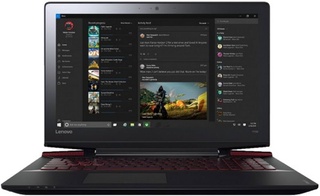Asus ROG Flow Z13 (2022) GZ301 13.4" Intel Core i5-12500H vs Lenovo IdeaPad Y700 15 15.6" Intel Core i7-6700HQ
Explore our in-depth comparison of the Asus ROG Flow Z13 (2022) GZ301 and the Lenovo IdeaPad Y700 15. Whether you're a dedicated gamer chasing top-tier performance or a user valuing functionality and style, we have you covered. Both laptops excel in their own right, but how do they stack up against each other? We will thoroughly examine their technical specs, design elements, and practical usability. Discover the strengths and areas for enhancement of each model. Join us as we analyze these devices to assist you in making an educated decision tailored to your requirements.
System and application performance
Performance in popular 3D games
Viewing angle, color accuracy...
Ports, webcam and other interfaces
Potential battery life
Materials, durability and portability
Performance Comparison
| Asus ROG Flow Z13 (2022) GZ301 13.4" Intel Core i5-12500H | Lenovo IdeaPad Y700 15 15.6" Intel Core i7-6700HQ | |
|---|---|---|
| Passmark | 22759 | 6550 |
| Passmark Single | 3669 | 1921 |
When assessing the Asus ROG Flow Z13 (2022) GZ301 against the Lenovo IdeaPad Y700 15, it's crucial to analyze particular benchmarks to grasp how their hardware specs impact practical tasks and applications.
Passmark Scores Comparison:
- Asus ROG Flow Z13 (2022) GZ301:
- Passmark Overall: 22759
- Passmark Single-Core: 3669
- Lenovo IdeaPad Y700 15:
- Passmark Overall: 6550
- Passmark Single-Core: 1921
Performance Analysis:
- The Asus ROG Flow Z13 (2022) outperforms the Lenovo IdeaPad Y700 15 in terms of performance due to its higher Passmark scores.The higher Passmark overall score signifies superior multi-core processing capability, essential for demanding tasks such as video editing, 3D rendering, and multitasking.
- A higher Passmark single-core score on the Asus ROG Flow Z13 indicates superior performance in tasks that rely on a single processing thread, such as gaming, office work, and web browsing.
Real-World Applications Impact:
- Design Software Rendering Speeds:
- The Asus ROG Flow Z13 would render designs faster due to its superior multi-core performance.
- Users working in design fields would benefit from quicker processing times and smoother workflow on the Asus model.
- Gaming Frame Rates:
- Players on the Asus ROG Flow Z13 can enjoy enhanced frame rates for a more immersive gaming experience.
- The enhanced single-core performance guarantees a seamless gaming experience with improved responsiveness when compared to the Lenovo IdeaPad Y700.
- Business Application Processing Speeds:
- Professionals handling intensive applications like data analysis or simulations would find the Asus ROG Flow Z13 more efficient.
- Tasks that demand quick calculations or data processing would be completed faster on the Asus laptop.
In conclusion, for users seeking enhanced performance across various tasks such as design work, gaming, or business applications, the Asus ROG Flow Z13 (2022) GZ301 stands out as a more capable choice due to its superior benchmark scores and optimized hardware specifications.
Design Comparison
Size Comparison
When analyzing the Asus ROG Flow Z13 (2022) GZ301 and the Lenovo IdeaPad Y700 15 in terms of design features that improve user experience, various crucial elements are at play. Let's explore how these laptops' design aspects impact practical usability and visual appeal to meet varying user requirements.
Ergonomics
- Asus ROG Flow Z13 (2022) GZ301: Weighing only 2.5 pounds and featuring a slim profile, this laptop is exceptionally portable, perfect for students and professionals who are frequently on the move.
- Lenovo IdeaPad Y700 15: Weighing in at 5.7 pounds, this laptop is heavier, potentially affecting portability yet providing added stability when placed on a desk.
Materials & Build Quality
- Asus ROG Flow Z13 (2022) GZ301: This laptop combines premium materials and a sleek design, making it an attractive choice for professionals seeking a stylish device.
- Lenovo IdeaPad Y700 15: The plastic construction, though solid, may lack the upscale impression of the Asus model.
Portability
- Asus ROG Flow Z13 (2022) GZ301: Its small size allows for convenient portability in a backpack or bag without extra weight.
- Lenovo IdeaPad Y700 15: The increased size and weight may not suit frequent travelers or individuals focused on portability.
Unique Design Features
- Asus ROG Flow Z13 (2022) GZ301:
- Backlit Keyboard: Improves user experience in dimly lit settings.
- Touch Screen: Offers additional input flexibility for intuitive interaction.
- Multiple USB ports including Thunderbolt 4: Catering to diverse connectivity needs.
- Lenovo IdeaPad Y700 15:
- HDMI Output: Convenient for connecting to external displays or projectors.
- RJ45 Ports: Ideal for users requiring wired network connectivity.
- Solid Stereo Speakers: Delivering quality audio output for multimedia consumption.
Practical Usability & Aesthetic Appeal
- Students: The Asus ROG Flow Z13's lightweight build and touch screen could appeal to students needing versatility and mobility. The backlit keyboard would be handy during late-night study sessions.
- Professionals: The Lenovo IdeaPad Y700's solid build quality and larger screen size might be more suitable for professionals working on tasks that require detailed visuals or multiple applications open simultaneously.
ConclusionWhen it comes to design features, the Asus ROG Flow Z13 (2022) GZ301 stands out for its portability, contemporary look, and unique touch screen capabilities. In contrast, the Lenovo IdeaPad Y700 15 provides durability and useful features such as an HDMI output, ideal for users with specific connectivity requirements.
Screen Comparison
| Asus ROG Flow Z13 (2022) GZ301 13.4" Intel Core i5-12500H | Lenovo IdeaPad Y700 15 15.6" Intel Core i7-6700HQ | |
|---|---|---|
| Resolution | Full HD | 4K |
| Screen Size | 13.4" | 15.6" |
Screen Comparison: Asus ROG Flow Z13 (2022) vs. Lenovo IdeaPad Y700
When you look at the screens of the Asus ROG Flow Z13 and the Lenovo IdeaPad Y700, various factors come into play that can greatly affect your user experience, be it for gaming or professional graphic design work.
Screen Size:
- Asus ROG Flow Z13 (2022): 13.4-inch display.
- Lenovo IdeaPad Y700: 15.6-inch display
Impact: - With its larger 15.6-inch screen, the Lenovo offers an immersive viewing experience, perfect for gaming and multimedia enjoyment that benefits from a wider field of view.The 13.4-inch screen on the Asus provides higher portability, making it ideal for users who value mobility without compromising screen size.
Resolution & Pixel Density:
- Asus ROG Flow Z13 (2022): 1920 x 1080 px, 168 ppi
- Lenovo IdeaPad Y700: 3840 x 1080 px, 282 ppi
Impact:- The Lenovo's higher resolution and pixel density deliver sharper images and text rendering, improving details in graphics-intensive applications or high-resolution content creation.
- On the other hand, the Asus provides good clarity at a standard Full HD resolution, which may suffice for most gaming needs while offering smooth performance.
Display Technology:
- Both laptops have IPS LCD LED-backlit displays that are touchscreen-enabled.
- The Lenovo additionally boasts an anti-reflection coating to reduce glare in bright environments.
Impact:
- IPS panels ensure excellent color reproduction and wide viewing angles on both laptops, making them suitable for tasks requiring color accuracy such as graphic design or photo editing.
- The anti-reflection coating on the Lenovo enhances outdoor usability by minimizing glare and reflections under direct light sources.
Supported Displays:
- Asus ROG Flow Z13 (2022): Supports up to 4 displays
- Lenovo IdeaPad Y700: Supports up to 3 displays
Impact:
- This feature can be beneficial for multitasking or setting up elaborate workstations with multiple monitors. A higher display support count allows for more versatile setups across different tasks or workflows.
Conclusion:
If you value mobility and portability but also need a strong display for gaming and daily tasks, the Asus ROG Flow Z13 might be a good fit with its compact size and Full HD resolution. However, if you prefer immersive viewing experiences and have demanding graphical needs that benefit from higher pixel density and screen space, the Lenovo IdeaPad Y700 provides sharper visuals and extra display support.
Hardware Comparison
| Asus ROG Flow Z13 (2022) GZ301 13.4" Intel Core i5-12500H | Lenovo IdeaPad Y700 15 15.6" Intel Core i7-6700HQ | |
|---|---|---|
| CPU | Intel Core i5-12500H | Intel Core i7-6700HQ |
| RAM | 16GB | 16GB |
| Storage Size | 512GB | 1256GB |
Asus ROG Flow Z13 (2022) GZ301 13.4" vs. Lenovo IdeaPad Y700 15: Hardware Comparison
Let's explore the hardware features of the Asus ROG Flow Z13 (2022) GZ301 and the Lenovo IdeaPad Y700 15 to assist you in making an informed decision according to your requirements.
CPU:
- Asus ROG Flow Z13: Features an Intel Core i5-12500H processor running at 2.5GHz.
- Lenovo IdeaPad Y700 is equipped with an Intel Core i7-6700HQ processor running at 2.6GHz.
Performance Impact: The Intel Core i5-12500H in the Asus features a newer architecture and higher clock speeds, potentially delivering improved performance for multitasking and demanding applications when compared to the older i7 in the Lenovo.
GPU:
Both laptops have integrated graphics, but specific details on GPU models are not provided in the specifications.
RAM:
- Asus ROG Flow Z13: 16GB DDR5 RAM
- Lenovo IdeaPad Y700: 16GB DDR4 RAM
Performance Impact: The DDR5 RAM in the Asus laptop could offer faster data transfer rates than the DDR4 RAM in the Lenovo model, potentially resulting in smoother multitasking and enhanced overall system responsiveness.
Storage:
- Asus ROG Flow Z13: 512GB SSD
- Lenovo IdeaPad Y700: 256GB SSD + 1000GB HDD
Performance Impact: The Asus' larger SSD capacity ensures faster boot times and quicker application loading than the Lenovo's combination of SSD and HDD storage, providing speedier access to stored data.
Conclusion:
- Consider the Asus ROG Flow Z13 if you value cutting-edge CPU technology and faster RAM for multitasking and performance-heavy activities.
- The Lenovo IdeaPad Y700 provides a well-rounded storage solution for users requiring both SSD speed and HDD capacity.
Verdict
Why Asus ROG Flow Z13 (2022) GZ301 13.4" Intel Core i5-12500H?
- Superior portability and lightweight design make it ideal for users on the move.
- Cutting-edge CPU technology and faster DDR5 RAM offer improved performance for multitasking and demanding applications.
- Backlit keyboard, touch screen, and Thunderbolt 4 support provide enhanced user experience and connectivity options.
Why ?
- Larger screen size for immersive viewing experience.
- Solid build quality with durable construction.
- Additional storage capacity with a combination of SSD and HDD.
Similar comparisons
- Asus ROG Flow X16 (2023) 16" QHD Plus Intel Core i9-13900H vs Samsung Galaxy Book3 Ultra 16" Intel Core i9-13900H
- Asus R558UR 15.6" Intel Core i5 6200U vs Asus Vivobook 15 X515JA 15.6" Intel Core i5-1035G1
- Asus Q552UB 15.6" Intel Core i7 6500U vs Lenovo IdeaPad Slim 3i Gen 12 14" Intel Core i3-1215U
- Asus EeeBook E402MA 14" Intel Pentium N3540 vs Lenovo IdeaPad 330S 15.6” AMD Ryzen 3 2200U
- Asus Chromebook Flip C302 12.5" Intel Core m3-6Y30 vs Voyo VBook V2 11.6" Intel Celeron N3450

